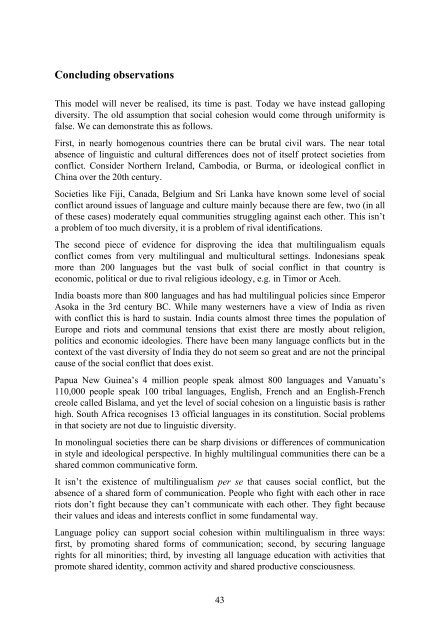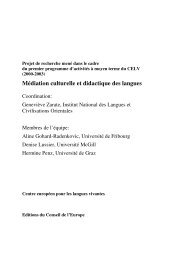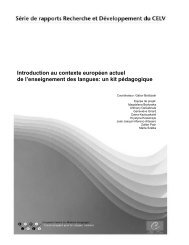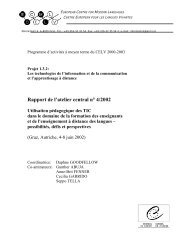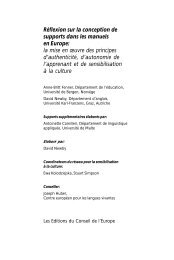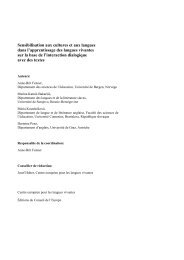cohesion - European Centre for Modern Languages
cohesion - European Centre for Modern Languages
cohesion - European Centre for Modern Languages
You also want an ePaper? Increase the reach of your titles
YUMPU automatically turns print PDFs into web optimized ePapers that Google loves.
Concluding observations<br />
This model will never be realised, its time is past. Today we have instead galloping<br />
diversity. The old assumption that social <strong>cohesion</strong> would come through uni<strong>for</strong>mity is<br />
false. We can demonstrate this as follows.<br />
First, in nearly homogenous countries there can be brutal civil wars. The near total<br />
absence of linguistic and cultural differences does not of itself protect societies from<br />
conflict. Consider Northern Ireland, Cambodia, or Burma, or ideological conflict in<br />
China over the 20th century.<br />
Societies like Fiji, Canada, Belgium and Sri Lanka have known some level of social<br />
conflict around issues of language and culture mainly because there are few, two (in all<br />
of these cases) moderately equal communities struggling against each other. This isn’t<br />
a problem of too much diversity, it is a problem of rival identifications.<br />
The second piece of evidence <strong>for</strong> disproving the idea that multilingualism equals<br />
conflict comes from very multilingual and multicultural settings. Indonesians speak<br />
more than 200 languages but the vast bulk of social conflict in that country is<br />
economic, political or due to rival religious ideology, e.g. in Timor or Aceh.<br />
India boasts more than 800 languages and has had multilingual policies since Emperor<br />
Asoka in the 3rd century BC. While many westerners have a view of India as riven<br />
with conflict this is hard to sustain. India counts almost three times the population of<br />
Europe and riots and communal tensions that exist there are mostly about religion,<br />
politics and economic ideologies. There have been many language conflicts but in the<br />
context of the vast diversity of India they do not seem so great and are not the principal<br />
cause of the social conflict that does exist.<br />
Papua New Guinea’s 4 million people speak almost 800 languages and Vanuatu’s<br />
110,000 people speak 100 tribal languages, English, French and an English-French<br />
creole called Bislama, and yet the level of social <strong>cohesion</strong> on a linguistic basis is rather<br />
high. South Africa recognises 13 official languages in its constitution. Social problems<br />
in that society are not due to linguistic diversity.<br />
In monolingual societies there can be sharp divisions or differences of communication<br />
in style and ideological perspective. In highly multilingual communities there can be a<br />
shared common communicative <strong>for</strong>m.<br />
It isn’t the existence of multilingualism per se that causes social conflict, but the<br />
absence of a shared <strong>for</strong>m of communication. People who fight with each other in race<br />
riots don’t fight because they can’t communicate with each other. They fight because<br />
their values and ideas and interests conflict in some fundamental way.<br />
Language policy can support social <strong>cohesion</strong> within multilingualism in three ways:<br />
first, by promoting shared <strong>for</strong>ms of communication; second, by securing language<br />
rights <strong>for</strong> all minorities; third, by investing all language education with activities that<br />
promote shared identity, common activity and shared productive consciousness.<br />
43


